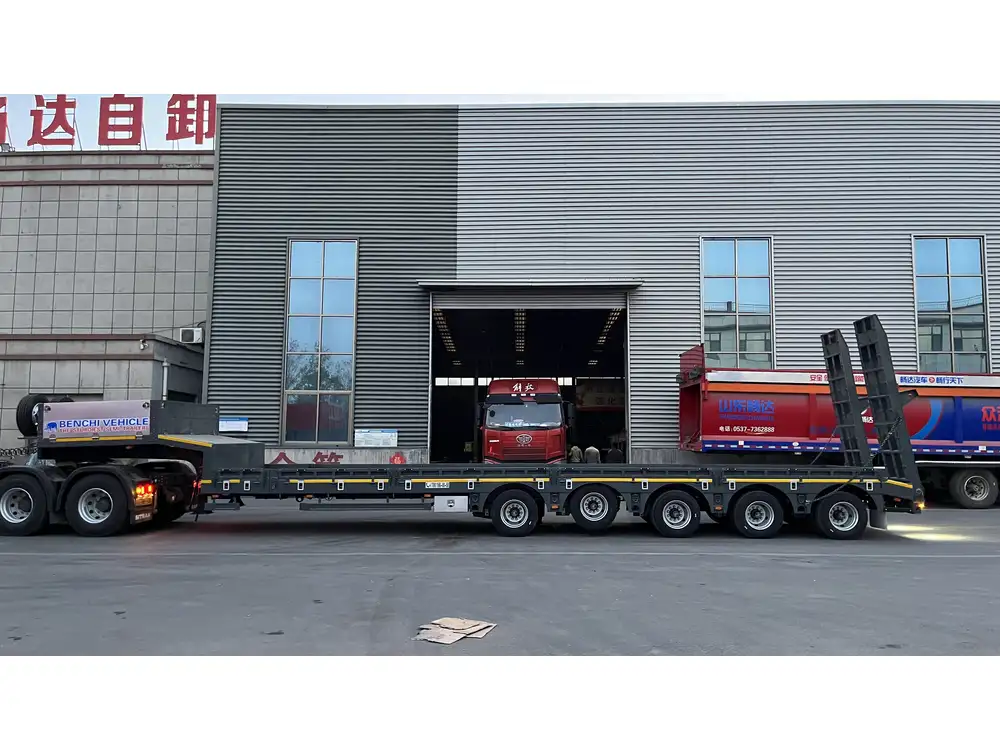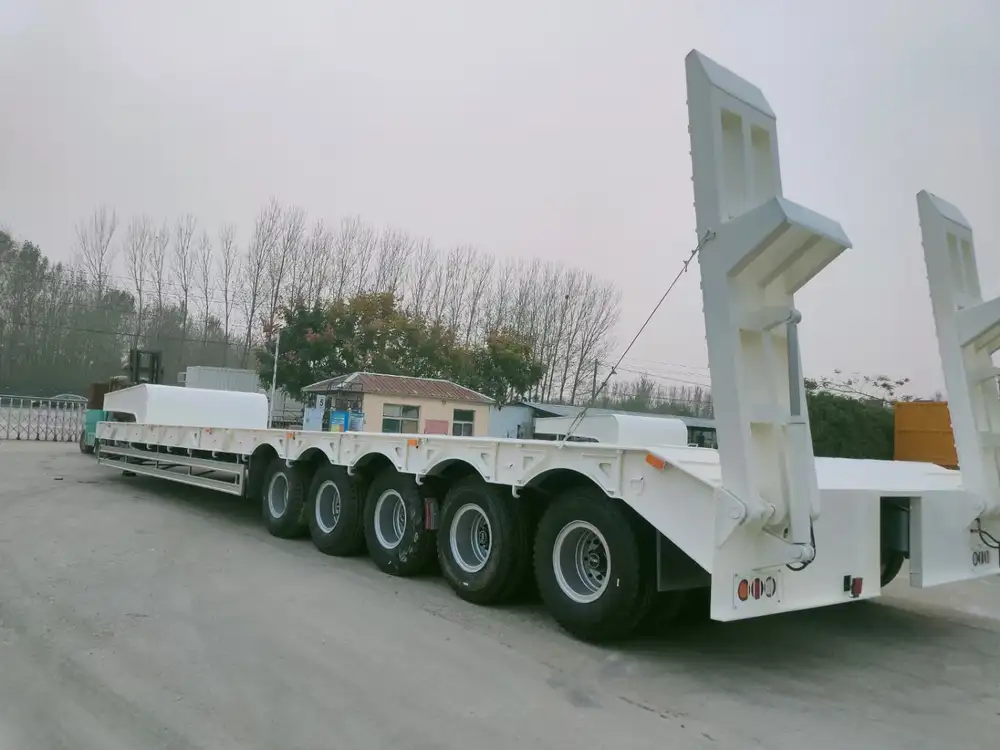The logistics world is constantly evolving, and selecting the right equipment is crucial for the safety, efficiency, and cost-effectiveness of transporting heavy goods. In the vibrant economic landscape of the Democratic Republic of the Congo (DRC), the demand for robust transportation solutions is ever-present. Among these, the low bed trailer with prime mover stands out as an essential asset for companies involved in construction, mining, and heavy machinery transportation.
This comprehensive guide delves deep into the features, advantages, and considerations of acquiring a low bed trailer with a prime mover, specifically tailored for operators in the Democratic Republic of the Congo.
Understanding the Low Bed Trailer
What is a Low Bed Trailer?
A low bed trailer is designed to transport heavy and oversized loads, such as construction equipment, machinery, and other substantial cargo. Unique in its construction, it maintains a lower ground clearance, which is essential for loading and unloading hefty items while adhering to load limit regulations.

Prime Movers: The Driving Force Behind Transportation
When considering the low bed trailer, it’s crucial to pair it with a powerful prime mover—this truck or tractor is equipped to haul trailers, ensuring that the heavy loads are moved efficiently across rugged terrains. The combination of a low bed trailer and a high-performance prime mover optimizes the logistics chain, enhancing productivity.
Benefits of Low Bed Trailers in the DRC
1. Enhanced Stability and Safety
Low bed trailers reduce the center of gravity, providing exceptional stability during transport. This design minimizes the risk of accidents caused by tipping or swaying, particularly important on the often uneven roads of the DRC.

2. Load Capacity and Versatility
The load capacity of low bed trailers is impressive. They can accommodate various types of loads, surpassing traditional trailers. This versatility means that companies can use them for transporting everything from heavy machinery to oversized cargo, making them an invaluable part of the fleet.
3. Regulatory Compliance
In the DRC, adhering to transportation regulations can be challenging. Low bed trailers meet the standards for transporting oversized loads, helping businesses avoid fines and enhance their operational legitimacy.
4. Cost Efficiency
Investing in a combination of low bed trailers and prime movers significantly optimizes transport costs. The ability to carry more substantial loads means fewer trips are necessary, ultimately saving on fuel and time—two critical factors in enhancing a business’s bottom line.

Selecting the Right Low Bed Trailer and Prime Mover
Acquiring a low bed trailer and prime mover is a significant investment. Here are pivotal factors to consider during your selection process.
1. Load Specifications
Before purchasing, determine the maximum weight and dimensions of the loads you will transport. This information will guide you in selecting a trailer that meets your specific needs and avoids overloading, which can lead to accidents and increased wear on the equipment.
| Specification | Consideration |
|---|---|
| Maximum Load Capacity | Evaluate the heaviest load |
| Bed Length | Match with load dimensions |
| Ramp Angles | Ensure easy loading/unloading |
2. Terrain Challenges
The terrain in the DRC can vary greatly—ranging from asphalt to gravel and mud roads. Selecting a trailer and prime mover combination that can handle these conditions will decrease the likelihood of breakdowns and expand your operational range.

3. Manufacturer’s Reputation
Opt for a trusted manufacturer like CarMax Trailer. With years of experience in producing high-quality trailers, CarMax Vehicle offers robust low bed trailers known for their durability and performance. Assess customer reviews and case studies to gauge reliability.
4. Maintenance and Support
Ensure that parts and service support are readily available in the DRC. Your equipment isn’t on the road if it’s in the shop, so ongoing maintenance and the availability of spare parts are critical considerations in your purchase decision.
Financial Considerations
Investing in a low bed trailer with a prime mover involves significant capital. Analyze the total cost of ownership, which includes purchase price, maintenance costs, operational costs, and potential resale value.
| Financial Aspect | Details |
|---|---|
| Initial Purchase Cost | Consider financing options |
| Maintenance Costs | Estimate annual budget for upkeep |
| Fuel Efficiency | Evaluate the fuel consumption of prime movers |
| Resale Value | Research market trends for similar equipment |

Financing Options
Explore financing options, such as loans or leasing agreements, to facilitate your purchase. Many manufacturers, including CarMax Trailer, offer flexible financing plans suitable for various business sizes.
Conclusion
The demand for reliable and efficient transport solutions is escalating in the Democratic Republic of the Congo. Investing in a low bed trailer with a prime mover is not merely a choice; it’s a strategic decision that can lead to significant operational advantages. The ability to transport heavy and oversized loads safely while maintaining compliance with local regulations will provide a substantial competitive edge.
By considering critical factors such as load specifications, terrain, vendor reputation, and financial aspects, businesses can choose the ideal equipment to meet their logistical demands. With CarMax Trailer’s commitment to quality, companies can ensure their operational fleets are equipped with the best possible trailers, paving the way for success in the transportation sector.
FAQs

1. What specific loads can be transported with a low bed trailer?
Low bed trailers are designed to transport heavy machinery, construction equipment, industrial materials, and oversized cargo that traditional trailers cannot accommodate.
2. How can I determine the right load capacity for my trailer?
Calculating the maximum load capacity involves assessing the weights and dimensions of your heaviest cargo. Consulting with manufacturers like CarMax Trailer can help refine your specifications.
3. What factors affect the lifespan of a low bed trailer?
Key factors include the quality of construction, load management practices, maintenance frequency, and the conditions in which the trailer is used.

4. Are there local regulations affecting low bed trailer usage in the DRC?
Yes, regulations often pertain to load dimensions, weight limits, and transport permits. It’s important to stay informed to ensure compliance and avoid legal issues.
By focusing on quality, strategic selection, and understanding local needs, businesses can effectively navigate the logistics landscape in the DRC, harnessing the potential of low bed trailers with prime movers to elevate their operations.











Reviews
There are no reviews yet.